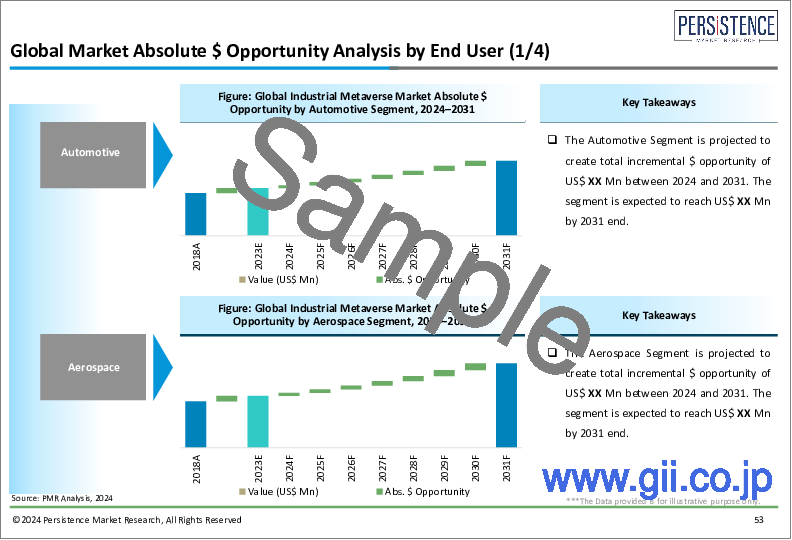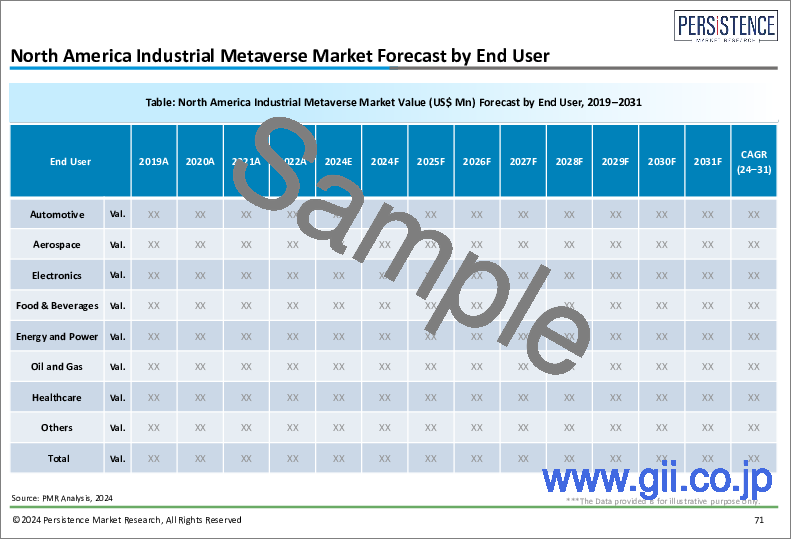|
|
市場調査レポート
商品コード
1537034
産業用メタバース市場:世界の産業分析、規模、シェア、成長、動向、2024-2033年予測Industrial Metaverse Market: Global Industry Analysis, Size, Share, Growth, Trends, and Forecast, 2024-2033 |
||||||
カスタマイズ可能
|
|||||||
| 産業用メタバース市場:世界の産業分析、規模、シェア、成長、動向、2024-2033年予測 |
|
出版日: 2024年08月12日
発行: Persistence Market Research
ページ情報: 英文 250 Pages
納期: 2~5営業日
|
- 全表示
- 概要
- 目次
Persistence Market Research社はこのほど、世界の産業用メタバース市場に関する包括的なレポートを発表しました。当レポートでは、市場促進要因・動向・機会・課題を含む重要な市場ダイナミクスを徹底的に評価し、市場構造に関する詳細な洞察を提供しています。
主要な洞察産業用メタバース市場
- 推定市場価値(2024年):1,004億米ドル
- 予測市場価値(2033年):7,658億米ドル
- 世界市場成長率(CAGR 2024年~2033年):25.3%
産業用メタバース市場- レポート範囲:
産業用メタバース市場には、様々な産業用途向けの仮想現実および拡張現実環境の開発、生産、実装が含まれます。これらのアプリケーションは、自動車、製造、建設などの分野にまたがり、設計、テスト、運用効率のための変革的なソリューションを提供します。
市場成長の促進要因:
産業用メタバースは、その変革の可能性により、さまざまな分野で採用が進んでいます。この急成長を促進する主な動向は以下の通り:
- 幅広い分野での採用:自動車、製造、建設などの多様なセクターへのメタバースの統合が、大きな促進要因となっています。
- プロトタイプのシミュレーション:製造分野でのメタバース、特に試作品のシミュレーションの重要性が高まっており、売上を押し上げると予想されます。
- 生産性とコスト効率:生産性の向上、作業体験の強化、全体的なコスト削減への注目が、産業用メタバース・ソリューションの採用を引き続き後押しします。
- デジタルツインとVR/ARの統合:デジタルツインの人気の高まりと、仮想現実(VR)、拡張現実(AR)、複合現実(MR)技術の統合が、市場の拡大を加速させています。
インダストリアル・メタバース:製造業に革命をもたらし、さらにその先へ
インダストリアル・メタバースは、企業が製品、システム、プロセスをコラボレーション、設計、テストするためのシミュレートされた3D環境を提供します。物理的な場所に関係なく、利害関係者がリアルタイムでコラボレーションできるようになり、イノベーションの触媒として台頭しています。このバーチャル環境は、時間のかかる高価な活動を完全にバーチャルな設定に移行することで、産業界が生産性を高め、コストを削減し、より持続的に行動することを可能にします。
自動車製造への大きな影響
自動車分野では、メタバースは製品設計、仮想テスト、組立ラインの最適化、遠隔コラボレーションなど、さまざまな用途に活用されています。自動車メーカーは、バーチャル・プロトタイプを作成することで、より迅速な設計の反復を可能にし、物理的なプロトタイプの必要性を減らすことができます。このプロセスにより、全体的な設計効率と製品品質が向上します。
IoTとの統合:ゲームチェンジャー
メタバースとモノのインターネット(IoT)の統合は、産業分野での拡大を促進しています。仮想環境を現実世界のセンサー、デバイス、データソースと接続することで、メタバースはリアルタイムのモニタリング、データの可視化、分析を可能にします。この統合により、企業はプロセスを最適化し、メンテナンスの必要性を予測し、業務効率を向上させることができます。
地域別の洞察:アジア太平洋と米国がリード
アジア太平洋:産業用メタバースの震源地
アジア太平洋地域は世界の産業用メタバース市場を独占し、その市場規模は2023年の416億米ドルから2033年には3,975億米ドルに成長すると予測されています。この地域、特に中国、日本、韓国などの国々における堅調な製造業が、この成長を牽引しています。製造業における産業用メタバース・ソリューションの採用は、コスト削減、効率性の向上、市場投入までの時間の短縮を可能にします。
米国:活況を呈する製造業で急成長
米国の産業用メタバース市場は、2033年までに1,404億米ドルに達し、2033年までの絶対成長率は1,257億米ドルに達すると予測されています。製造業の生産高が大きく、先端技術の導入が進んでいるため、産業用メタバースはエンドユーザーが生産ラインの仮想レプリカを作成し、プロセスをシミュレーションして最適化し、効率を高めるのに役立っています。
本レポートで扱う主な質問
- 産業用メタバース市場の成長を促進する主な要因は何か?
- 産業用メタバースソリューションの採用をリードしている消費者セグメントは?
- メタバース技術の進歩は競合情勢にどのような影響を与えているか?
- 世界の産業用メタバース市場における主要プレイヤーは誰で、市場ポジションを維持するためにどのような戦略を採用しているのか?
- 世界の産業用メタバース市場における新たな動向と将来性は?
目次
第1章 エグゼクティブサマリー
第2章 市場概要
- 市場範囲/ 分類
- 市場の定義/ 範囲/ 制限
第3章 市場背景
- 市場力学
- シナリオ予測
- 機会マップ分析
- 投資実現可能性マトリックス
- PESTLEとポーター分析
- 規制状況
- 地域親市場見通し
第4章 世界の産業用メタバース市場分析
- 過去の市場規模価値(10億米ドル)分析、2019年~2023年
- 現在および将来の市場規模価値(10億米ドル)予測、2024~2033年
- 前年比成長動向分析
- 絶対的収益機会
第5章 技術別:世界の産業用メタバース市場分析
- イントロダクション/主な調査結果
- 市場規模(金額)分析、2019~2023年
- 市場規模(金額)分析と予測、2024~2033年
- バーチャルリアリティ(VR)
- 拡張現実(AR)
- 複合現実(MR)
- 前年比成長動向分析、2019~2023年
- 絶対的収益機会、2024~2033年
第6章 アプリケーション別:世界の産業用メタバース市場分析
- イントロダクション/主な調査結果
- 市場規模(金額)分析、2019~2023年
- 市場規模(金額)分析と予測、2024~2033年
- トレーニングとシミュレーション
- リモートコラボレーション
- 製品設計と開発
- 資産運用管理
- サプライチェーンマネジメント
- 顧客サービス
- 製造業
- ロジスティクス
- ヘルスケア
- 教育
- 前年比成長動向分析、2019~2023年
- 絶対的収益機会、2024~2033年
第7章 地域別:世界の産業用メタバース市場分析
- イントロダクション
- 市場規模(金額)分析、2019~2023年
- 市場規模(金額)分析と予測、2024~2033年
- 北米
- ラテンアメリカ
- 欧州
- 南アジア
- 東アジア
- オセアニア
- 中東・アフリカ
- 地域別市場の魅力分析
第8章 北米の産業用メタバース市場分析(国別)
第9章 ラテンアメリカの産業用メタバース市場分析(国別)
第10章 欧州の産業用メタバース市場分析(国別)
第11章 南アジア産業用メタバース市場分析(国別)
第12章 東アジアの産業用メタバース市場分析(国別)
第13章 オセアニアの産業用メタバース市場分析(国別)
第14章 中東およびアフリカの産業用メタバース市場分析(国別)
第15章 主要国の産業用メタバース市場分析
- 米国
- カナダ
- ブラジル
- メキシコ
- ドイツ
- 英国
- フランス
- スペイン
- イタリア
- インド
- マレーシア
- シンガポール
- タイ
- 中国
- 日本
- 韓国
- オーストラリア
- ニュージーランド
- GCC諸国
- 南アフリカ
- イスラエル
第16章 市場構造分析
- 競合ダッシュボード
- 競合ベンチマーク
- 主要企業の市場シェア分析
第17章 競合分析
- 競合の詳細
- Microsoft
- Meta
- Unity Software
- Epic Games
- NVIDIA
- HTC
- Sony
- Magic Leap
- Apple
第18章 使用される前提条件と頭字語
第19章 調査手法
Persistence Market Research has recently released a comprehensive report on the global industrial metaverse market. The report offers a thorough assessment of crucial market dynamics, including drivers, trends, opportunities, and challenges, providing detailed insights into the market structure.
Key Insights: Industrial Metaverse Market
- Estimated Market Value (2024): USD 100.4 Billion
- Projected Market Value (2033): USD 765.8 Billion
- Global Market Growth Rate (CAGR 2024 to 2033): 25.3%
Industrial Metaverse Market - Report Scope:
The industrial metaverse market involves the development, production, and implementation of virtual and augmented reality environments for various industrial applications. These applications span sectors such as automotive, manufacturing, construction, and more, offering transformative solutions for design, testing, and operational efficiency.
Market Growth Drivers:
Increase in Incidence and Prevalence of Sport Injuries and Fractures
The industrial metaverse is increasingly being adopted across various sectors due to its transformative potential. Key trends driving this surge include:
- Wide Sector Adoption: The integration of the metaverse into diverse sectors such as automotive, manufacturing, and construction is a significant growth driver.
- Simulation for Prototypes: The growing importance of the metaverse in the manufacturing sector, particularly for running simulations of prototypes, is expected to boost sales.
- Productivity and Cost Efficiency: The focus on improving productivity, enhancing work experience, and reducing overall costs continues to encourage the adoption of industrial metaverse solutions.
- Digital Twins and VR/AR Integration: The rising popularity of digital twins and the integration of virtual reality (VR), augmented reality (AR), and mixed reality (MR) technologies are accelerating market expansion.
Industrial Metaverse: Revolutionizing Manufacturing and Beyond
The industrial metaverse offers a simulated, 3D environment for businesses to collaborate, design, and test products, systems, and processes. It is emerging as a catalyst for innovation, allowing stakeholders to collaborate in real-time, regardless of their physical location. This virtual environment enables industries to enhance productivity, cut costs, and act more sustainably by transferring time-consuming and expensive activities into fully virtual settings.
Significant Impact on Automotive Manufacturing
In the automotive sector, the metaverse is utilized for various applications, including product design, virtual testing, assembly line optimization, and remote collaboration. Automotive manufacturers benefit from creating virtual prototypes, allowing for quicker design iterations and reducing the need for physical prototypes. This process enhances overall design efficiency and product quality.
Integration with IoT: A Game-Changer
The integration of the metaverse with the Internet of Things (IoT) is driving its expansion in the industrial sector. By connecting virtual environments with real-world sensors, devices, and data sources, the metaverse enables real-time monitoring, data visualization, and analysis. This integration allows businesses to optimize processes, predict maintenance needs, and improve operational efficiency.
Regional Insights: Asia Pacific and the United States Lead the Way
Asia Pacific: The Epicenter of Industrial Metaverse
Asia Pacific is expected to dominate the global industrial metaverse market, with its value projected to grow from US$ 41.6 billion in 2023 to US$ 397.5 billion by 2033. The region's robust manufacturing industry, particularly in countries like China, Japan, and South Korea, is driving this growth. The adoption of industrial metaverse solutions in manufacturing enables cost savings, increased efficiency, and accelerated time-to-market.
United States: Rapid Growth in a Booming Manufacturing Sector
The United States industrial metaverse market is forecasted to reach US$ 140.4 billion by 2033, creating an absolute growth of US$ 125.7 billion through 2033. With a significant manufacturing output and the high adoption of advanced technologies, the industrial metaverse helps end-users create virtual replicas of production lines, simulate and optimize processes, and increase efficiency.
Key Questions Answered in the Report:
- What are the primary factors driving the growth of the industrial metaverse market?
- Which consumer segments are leading the adoption of industrial metaverse solutions?
- How are advancements in metaverse technology influencing the competitive landscape?
- Who are the key players in the global industrial metaverse market, and what strategies are they employing to maintain their market position?
- What are the emerging trends and future prospects in the global industrial metaverse market?
Competitive Intelligence and Business Strategy:
Leading players in the global industrial metaverse market, such as Microsoft, Meta, Unity Software, Epic Games, NVIDIA, and others, focus on innovation, strategic partnerships, and marketing excellence to gain a competitive edge. These companies invest heavily in R&D to develop advanced industrial metaverse solutions and expand their product lines. Collaborations with technology developers and industry-specific organizations enhance market credibility and support the development of innovative solutions. Additionally, leveraging digital marketing and influencer partnerships strengthens market positioning and consumer engagement.
Key Companies Profiled:
- Microsoft
- Meta
- Unity Software
- Epic Games
- NVIDIA
- HTC
- Sony
- Magic Leap
- Apple
Industrial Metaverse Market Segmentation:
By Technology:
- Virtual Reality (VR)
- Augmented Reality (AR)
- Mixed Reality (MR)
By Application:
- Training and Simulation
- Remote Collaboration
- Product Design and Development
- Asset Management
- Supply Chain Management
- Customer Service
- Manufacturing
- Logistics
- Healthcare
- Education
By Region:
- North America
- Latin America
- Europe
- Asia Pacific
- Middle East and Africa
Table of Contents
1. Executive Summary
- 1.1. Global Market Outlook
- 1.2. Demand-side Trends
- 1.3. Supply-side Trends
- 1.4. Technology Roadmap Analysis
- 1.5. Analysis and Recommendations
2. Market Overview
- 2.1. Market Coverage / Taxonomy
- 2.2. Market Definition / Scope / Limitations
3. Market Background
- 3.1. Market Dynamics
- 3.1.1. Drivers
- 3.1.2. Restraints
- 3.1.3. Opportunity
- 3.1.4. Trends
- 3.2. Scenario Forecast
- 3.2.1. Demand in Optimistic Scenario
- 3.2.2. Demand in Likely Scenario
- 3.2.3. Demand in Conservative Scenario
- 3.3. Opportunity Map Analysis
- 3.4. Investment Feasibility Matrix
- 3.5. PESTLE and Porter's Analysis
- 3.6. Regulatory Landscape
- 3.6.1. By Key Regions
- 3.6.2. By Key Countries
- 3.7. Regional Parent Market Outlook
4. Global Industrial Metaverse Market Analysis 2019-2023 and Forecast, 2024-2033
- 4.1. Historical Market Size Value (US$ Bn) Analysis, 2019-2023
- 4.2. Current and Future Market Size Value (US$ Bn) Projections, 2024-2033
- 4.2.1. Y-o-Y Growth Trend Analysis
- 4.2.2. Absolute $ Opportunity Analysis
5. Global Industrial Metaverse Market Analysis 2019-2023 and Forecast 2024-2033, By Technology
- 5.1. Introduction / Key Findings
- 5.2. Historical Market Size Value (US$ Bn) Analysis By Technology, 2019-2023
- 5.3. Current and Future Market Size Value (US$ Bn) Analysis and Forecast By Technology, 2024-2033
- 5.3.1. Virtual reality (VR)
- 5.3.2. Augmented reality (AR)
- 5.3.3. Mixed reality (MR)
- 5.4. Y-o-Y Growth Trend Analysis By Technology, 2019-2023
- 5.5. Absolute $ Opportunity Analysis By Technology, 2024-2033
6. Global Industrial Metaverse Market Analysis 2019-2023 and Forecast 2024-2033, By Application
- 6.1. Introduction / Key Findings
- 6.2. Historical Market Size Value (US$ Bn) Analysis By Application, 2019-2023
- 6.3. Current and Future Market Size Value (US$ Bn) Analysis and Forecast By Application, 2024-2033
- 6.3.1. Training and simulation
- 6.3.2. Remote collaboration
- 6.3.3. Product design and development
- 6.3.4. Asset management
- 6.3.5. Supply chain management
- 6.3.6. Customer service
- 6.3.7. Manufacturing
- 6.3.8. Logistics
- 6.3.9. Healthcare
- 6.3.10. Education
- 6.4. Y-o-Y Growth Trend Analysis By Application, 2019-2023
- 6.5. Absolute $ Opportunity Analysis By Application, 2024-2033
7. Global Industrial Metaverse Market Analysis 2019-2023 and Forecast 2024-2033, By Region
- 7.1. Introduction
- 7.2. Historical Market Size Value (US$ Bn) Analysis By Region, 2019-2023
- 7.3. Current Market Size Value (US$ Bn) Analysis and Forecast By Region, 2024-2033
- 7.3.1. North America
- 7.3.2. Latin America
- 7.3.3. Europe
- 7.3.4. South Asia
- 7.3.5. East Asia
- 7.3.6. Oceania
- 7.3.7. Middle East & Africa
- 7.4. Market Attractiveness Analysis By Region
8. North America Industrial Metaverse Market Analysis 2019-2023 and Forecast 2024-2033, By Country
- 8.1. Historical Market Size Value (US$ Bn) Trend Analysis By Market Taxonomy, 2019-2023
- 8.2. Market Size Value (US$ Bn) Forecast By Market Taxonomy, 2024-2033
- 8.2.1. By Country
- 8.2.1.1. United States
- 8.2.1.2. Canada
- 8.2.2. By Technology
- 8.2.3. By Application
- 8.2.1. By Country
- 8.3. Market Attractiveness Analysis
- 8.3.1. By Country
- 8.3.2. By Technology
- 8.3.3. By Application
- 8.4. Key Takeaways
9. Latin America Industrial Metaverse Market Analysis 2019-2023 and Forecast 2024-2033, By Country
- 9.1. Historical Market Size Value (US$ Bn) Trend Analysis By Market Taxonomy, 2019-2023
- 9.2. Market Size Value (US$ Bn) Forecast By Market Taxonomy, 2024-2033
- 9.2.1. By Country
- 9.2.1.1. Brazil
- 9.2.1.2. Mexico
- 9.2.1.3. Rest of Latin America
- 9.2.2. By Technology
- 9.2.3. By Application
- 9.2.1. By Country
- 9.3. Market Attractiveness Analysis
- 9.3.1. By Country
- 9.3.2. By Technology
- 9.3.3. By Application
- 9.4. Key Takeaways
10. Europe Industrial Metaverse Market Analysis 2019-2023 and Forecast 2024-2033, By Country
- 10.1. Historical Market Size Value (US$ Bn) Trend Analysis By Market Taxonomy, 2019-2023
- 10.2. Market Size Value (US$ Bn) Forecast By Market Taxonomy, 2024-2033
- 10.2.1. By Country
- 10.2.1.1. Germany
- 10.2.1.2. United Kingdom
- 10.2.1.3. France
- 10.2.1.4. Spain
- 10.2.1.5. Italy
- 10.2.1.6. Rest of Europe
- 10.2.2. By Technology
- 10.2.3. By Application
- 10.2.1. By Country
- 10.3. Market Attractiveness Analysis
- 10.3.1. By Country
- 10.3.2. By Technology
- 10.3.3. By Application
- 10.4. Key Takeaways
11. South Asia Industrial Metaverse Market Analysis 2019-2023 and Forecast 2024-2033, By Country
- 11.1. Historical Market Size Value (US$ Bn) Trend Analysis By Market Taxonomy, 2019-2023
- 11.2. Market Size Value (US$ Bn) Forecast By Market Taxonomy, 2024-2033
- 11.2.1. By Country
- 11.2.1.1. India
- 11.2.1.2. Malaysia
- 11.2.1.3. Singapore
- 11.2.1.4. Thailand
- 11.2.1.5. Rest of South Asia
- 11.2.2. By Technology
- 11.2.3. By Application
- 11.2.1. By Country
- 11.3. Market Attractiveness Analysis
- 11.3.1. By Country
- 11.3.2. By Technology
- 11.3.3. By Application
- 11.4. Key Takeaways
12. East Asia Industrial Metaverse Market Analysis 2019-2023 and Forecast 2024-2033, By Country
- 12.1. Historical Market Size Value (US$ Bn) Trend Analysis By Market Taxonomy, 2019-2023
- 12.2. Market Size Value (US$ Bn) Forecast By Market Taxonomy, 2024-2033
- 12.2.1. By Country
- 12.2.1.1. China
- 12.2.1.2. Japan
- 12.2.1.3. South Korea
- 12.2.2. By Technology
- 12.2.3. By Application
- 12.2.1. By Country
- 12.3. Market Attractiveness Analysis
- 12.3.1. By Country
- 12.3.2. By Technology
- 12.3.3. By Application
- 12.4. Key Takeaways
13. Oceania Industrial Metaverse Market Analysis 2019-2023 and Forecast 2024-2033, By Country
- 13.1. Historical Market Size Value (US$ Bn) Trend Analysis By Market Taxonomy, 2019-2023
- 13.2. Market Size Value (US$ Bn) Forecast By Market Taxonomy, 2024-2033
- 13.2.1. By Country
- 13.2.1.1. Australia
- 13.2.1.2. New Zealand
- 13.2.2. By Technology
- 13.2.3. By Application
- 13.2.1. By Country
- 13.3. Market Attractiveness Analysis
- 13.3.1. By Country
- 13.3.2. By Technology
- 13.3.3. By Application
- 13.4. Key Takeaways
14. Middle East & Africa Industrial Metaverse Market Analysis 2019-2023 and Forecast 2024-2033, By Country
- 14.1. Historical Market Size Value (US$ Bn) Trend Analysis By Market Taxonomy, 2019-2023
- 14.2. Market Size Value (US$ Bn) Forecast By Market Taxonomy, 2024-2033
- 14.2.1. By Country
- 14.2.1.1. GCC Countries
- 14.2.1.2. South Africa
- 14.2.1.3. Israel
- 14.2.1.4. Rest of Middle East & Africa
- 14.2.2. By Technology
- 14.2.3. By Application
- 14.2.1. By Country
- 14.3. Market Attractiveness Analysis
- 14.3.1. By Country
- 14.3.2. By Technology
- 14.3.3. By Application
- 14.4. Key Takeaways
15. Key Countries Industrial Metaverse Market Analysis
- 15.1. United States
- 15.1.1. Pricing Analysis
- 15.1.2. Market Share Analysis, 2023
- 15.1.2.1. By Technology
- 15.1.2.2. By Application
- 15.2. Canada
- 15.2.1. Pricing Analysis
- 15.2.2. Market Share Analysis, 2023
- 15.2.2.1. By Technology
- 15.2.2.2. By Application
- 15.3. Brazil
- 15.3.1. Pricing Analysis
- 15.3.2. Market Share Analysis, 2023
- 15.3.2.1. By Technology
- 15.3.2.2. By Application
- 15.4. Mexico
- 15.4.1. Pricing Analysis
- 15.4.2. Market Share Analysis, 2023
- 15.4.2.1. By Technology
- 15.4.2.2. By Application
- 15.5. Germany
- 15.5.1. Pricing Analysis
- 15.5.2. Market Share Analysis, 2023
- 15.5.2.1. By Technology
- 15.5.2.2. By Application
- 15.6. United Kingdom
- 15.6.1. Pricing Analysis
- 15.6.2. Market Share Analysis, 2023
- 15.6.2.1. By Technology
- 15.6.2.2. By Application
- 15.7. France
- 15.7.1. Pricing Analysis
- 15.7.2. Market Share Analysis, 2023
- 15.7.2.1. By Technology
- 15.7.2.2. By Application
- 15.8. Spain
- 15.8.1. Pricing Analysis
- 15.8.2. Market Share Analysis, 2023
- 15.8.2.1. By Technology
- 15.8.2.2. By Application
- 15.9. Italy
- 15.9.1. Pricing Analysis
- 15.9.2. Market Share Analysis, 2023
- 15.9.2.1. By Technology
- 15.9.2.2. By Application
- 15.10. India
- 15.10.1. Pricing Analysis
- 15.10.2. Market Share Analysis, 2023
- 15.10.2.1. By Technology
- 15.10.2.2. By Application
- 15.11. Malaysia
- 15.11.1. Pricing Analysis
- 15.11.2. Market Share Analysis, 2023
- 15.11.2.1. By Technology
- 15.11.2.2. By Application
- 15.12. Singapore
- 15.12.1. Pricing Analysis
- 15.12.2. Market Share Analysis, 2023
- 15.12.2.1. By Technology
- 15.12.2.2. By Application
- 15.13. Thailand
- 15.13.1. Pricing Analysis
- 15.13.2. Market Share Analysis, 2023
- 15.13.2.1. By Technology
- 15.13.2.2. By Application
- 15.14. China
- 15.14.1. Pricing Analysis
- 15.14.2. Market Share Analysis, 2023
- 15.14.2.1. By Technology
- 15.14.2.2. By Application
- 15.15. Japan
- 15.15.1. Pricing Analysis
- 15.15.2. Market Share Analysis, 2023
- 15.15.2.1. By Technology
- 15.15.2.2. By Application
- 15.16. South Korea
- 15.16.1. Pricing Analysis
- 15.16.2. Market Share Analysis, 2023
- 15.16.2.1. By Technology
- 15.16.2.2. By Application
- 15.17. Australia
- 15.17.1. Pricing Analysis
- 15.17.2. Market Share Analysis, 2024
- 15.17.2.1. By Technology
- 15.17.2.2. By Application
- 15.18. New Zealand
- 15.18.1. Pricing Analysis
- 15.18.2. Market Share Analysis, 2023
- 15.18.2.1. By Technology
- 15.18.2.2. By Application
- 15.19. GCC Countries
- 15.19.1. Pricing Analysis
- 15.19.2. Market Share Analysis, 2023
- 15.19.2.1. By Technology
- 15.19.2.2. By Application
- 15.20. South Africa
- 15.20.1. Pricing Analysis
- 15.20.2. Market Share Analysis, 2023
- 15.20.2.1. By Technology
- 15.20.2.2. By Application
- 15.21. Israel
- 15.21.1. Pricing Analysis
- 15.21.2. Market Share Analysis, 2023
- 15.21.2.1. By Technology
- 15.21.2.2. By Application
16. Market Structure Analysis
- 16.1. Competition Dashboard
- 16.2. Competition Benchmarking
- 16.3. Market Share Analysis of Top Players
- 16.3.1. By Regional
- 16.3.2. By Technology
- 16.3.3. By Application
17. Competition Analysis
- 17.1. Competition Deep Dive
- 17.1.1. Microsoft
- 17.1.1.1. Overview
- 17.1.1.2. Product Portfolio
- 17.1.1.3. Profitability by Market Segments
- 17.1.1.4. Sales Footprint
- 17.1.1.5. Strategy Overview
- 17.1.1.5.1. Marketing Strategy
- 17.1.2. Meta
- 17.1.2.1. Overview
- 17.1.2.2. Product Portfolio
- 17.1.2.3. Profitability by Market Segments
- 17.1.2.4. Sales Footprint
- 17.1.2.5. Strategy Overview
- 17.1.2.5.1. Marketing Strategy
- 17.1.3. Unity Software
- 17.1.3.1. Overview
- 17.1.3.2. Product Portfolio
- 17.1.3.3. Profitability by Market Segments
- 17.1.3.4. Sales Footprint
- 17.1.3.5. Strategy Overview
- 17.1.3.5.1. Marketing Strategy
- 17.1.4. Epic Games
- 17.1.4.1. Overview
- 17.1.4.2. Product Portfolio
- 17.1.4.3. Profitability by Market Segments
- 17.1.4.4. Sales Footprint
- 17.1.4.5. Strategy Overview
- 17.1.4.5.1. Marketing Strategy
- 17.1.5. NVIDIA
- 17.1.5.1. Overview
- 17.1.5.2. Product Portfolio
- 17.1.5.3. Profitability by Market Segments
- 17.1.5.4. Sales Footprint
- 17.1.5.5. Strategy Overview
- 17.1.5.5.1. Marketing Strategy
- 17.1.6. HTC
- 17.1.6.1. Overview
- 17.1.6.2. Product Portfolio
- 17.1.6.3. Profitability by Market Segments
- 17.1.6.4. Sales Footprint
- 17.1.6.5. Strategy Overview
- 17.1.6.5.1. Marketing Strategy
- 17.1.7. Sony
- 17.1.7.1. Overview
- 17.1.7.2. Product Portfolio
- 17.1.7.3. Profitability by Market Segments
- 17.1.7.4. Sales Footprint
- 17.1.7.5. Strategy Overview
- 17.1.7.5.1. Marketing Strategy
- 17.1.8. Magic Leap
- 17.1.8.1. Overview
- 17.1.8.2. Product Portfolio
- 17.1.8.3. Profitability by Market Segments
- 17.1.8.4. Sales Footprint
- 17.1.8.5. Strategy Overview
- 17.1.8.5.1. Marketing Strategy
- 17.1.9. Apple
- 17.1.9.1. Overview
- 17.1.9.2. Product Portfolio
- 17.1.9.3. Profitability by Market Segments
- 17.1.9.4. Sales Footprint
- 17.1.9.5. Strategy Overview
- 17.1.9.5.1. Marketing Strategy
- 17.1.10. Google
- 17.1.10.1. Overview
- 17.1.10.2. Product Portfolio
- 17.1.10.3. Profitability by Market Segments
- 17.1.10.4. Sales Footprint
- 17.1.10.5. Strategy Overview
- 17.1.10.5.1. Marketing Strategy
- 17.1.1. Microsoft





